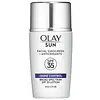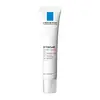What's inside
What's inside
 Key Ingredients
Key Ingredients

 Benefits
Benefits

 Concerns
Concerns

 Ingredients Side-by-side
Ingredients Side-by-side

Octocrylene 3%
UV AbsorberWater
Skin ConditioningTapioca Starch
Dimethicone
EmollientNiacinamide
SmoothingCamellia Sinensis Leaf Extract
AntimicrobialBHT
AntioxidantCaprylyl Glycol
EmollientDimethiconol
EmollientCetearyl Glucoside
EmulsifyingCetearyl Alcohol
EmollientTocopheryl Acetate
AntioxidantStearic Acid
CleansingPalmitic Acid
EmollientDisodium EDTA
PEG-100 Stearate
Polymethylsilsesquioxane
Sodium Polyacrylate Starch
Absorbent1,2-Hexanediol
Skin ConditioningPhenoxyethanol
PreservativeIodopropynyl Butylcarbamate
PreservativeParfum
MaskingOctocrylene 3%, Water, Tapioca Starch, Dimethicone, Niacinamide, Camellia Sinensis Leaf Extract, BHT, Caprylyl Glycol, Dimethiconol, Cetearyl Glucoside, Cetearyl Alcohol, Tocopheryl Acetate, Stearic Acid, Palmitic Acid, Disodium EDTA, PEG-100 Stearate, Polymethylsilsesquioxane, Sodium Polyacrylate Starch, 1,2-Hexanediol, Phenoxyethanol, Iodopropynyl Butylcarbamate, Parfum
Water
Skin ConditioningOctocrylene
UV AbsorberGlycerin
HumectantHomosalate
Skin ConditioningEthylhexyl Salicylate
UV AbsorberAlcohol Denat.
AntimicrobialNiacinamide
SmoothingButyl Methoxydibenzoylmethane
UV AbsorberDimethicone
EmollientSorbitan Stearate
EmulsifyingSilica
AbrasiveIsopropyl Lauroyl Sarcosinate
Skin ConditioningStyrene/Acrylates Copolymer
Propylene Glycol
HumectantPotassium Cetyl Phosphate
EmulsifyingDiisopropyl Sebacate
EmollientPEG-20
HumectantPEG-8 Laurate
EmulsifyingZinc PCA
HumectantDimethicone/Vinyl Dimethicone Crosspolymer
Skin ConditioningOleamide
2-Oleamido-1,3-Octadecanediol
Skin ConditioningInulin Lauryl Carbamate
Emulsion StabilisingCarnosine
Skin ConditioningPoloxamer 338
EmulsifyingAmmonium Polyacryloyldimethyl Taurate
Emulsion StabilisingDisodium EDTA
Sucrose Cocoate
EmulsifyingCapryloyl Salicylic Acid
ExfoliatingXanthan Gum
EmulsifyingT-Butyl Alcohol
PerfumingBHT
AntioxidantSalicylic Acid
MaskingParfum
MaskingWater, Octocrylene, Glycerin, Homosalate, Ethylhexyl Salicylate, Alcohol Denat., Niacinamide, Butyl Methoxydibenzoylmethane, Dimethicone, Sorbitan Stearate, Silica, Isopropyl Lauroyl Sarcosinate, Styrene/Acrylates Copolymer, Propylene Glycol, Potassium Cetyl Phosphate, Diisopropyl Sebacate, PEG-20, PEG-8 Laurate, Zinc PCA, Dimethicone/Vinyl Dimethicone Crosspolymer, Oleamide, 2-Oleamido-1,3-Octadecanediol, Inulin Lauryl Carbamate, Carnosine, Poloxamer 338, Ammonium Polyacryloyldimethyl Taurate, Disodium EDTA, Sucrose Cocoate, Capryloyl Salicylic Acid, Xanthan Gum, T-Butyl Alcohol, BHT, Salicylic Acid, Parfum
 Reviews
Reviews

Ingredients Explained
These ingredients are found in both products.
Ingredients higher up in an ingredient list are typically present in a larger amount.
BHT is a synthetic antioxidant and preservative.
As an antioxidant, it helps your body fight off free-radicals. Free-radicals are molecules that may damage your skin cells.
As a preservative, it is used to stabilize products and prevent them from degrading. Specifically, BHT prevents degradation from oxidation.
The concerns related to BHT come from oral studies; this ingredient is currently allowed for use by both the FDA and EU.
However, it was recently restricted for use in the UK as of April 2024.
Learn more about BHTDimethicone is a type of synthetic silicone created from natural materials such as quartz.
What it does:
Dimethicone comes in different viscosities:
Depending on the viscosity, dimethicone has different properties.
Ingredients lists don't always show which type is used, so we recommend reaching out to the brand if you have questions about the viscosity.
This ingredient is unlikely to cause irritation because it does not get absorbed into skin. However, people with silicone allergies should be careful about using this ingredient.
Note: Dimethicone may contribute to pilling. This is because it is not oil or water soluble, so pilling may occur when layered with products. When mixed with heavy oils in a formula, the outcome is also quite greasy.
Learn more about DimethiconeDisodium EDTA plays a role in making products more stable by aiding other preservatives.
It is a chelating agent, meaning it neutralizes metal ions that may be found in a product.
Disodium EDTA is a salt of edetic acid and is found to be safe in cosmetic ingredients.
Learn more about Disodium EDTANiacinamide is a multitasking form of vitamin B3 that strengthens the skin barrier, reduces pores and dark spots, regulates oil, and improves signs of aging.
And the best part? It's gentle and well-tolerated by most skin types, including sensitive and reactive skin.
You might have heard of "niacin flush", or the reddening of skin that causes itchiness. Niacinamide has not been found to cause this.
In very rare cases, some individuals may not be able to tolerate niacinamide at all or experience an allergic reaction to it.
If you are experiencing flaking, irritation, and dryness with this ingredient, be sure to double check all your products as this ingredient can be found in all categories of skincare.
When incorporating niacinamide into your routine, look out for concentration amounts. Typically, 5% niacinamide provides benefits such as fading dark spots. However, if you have sensitive skin, it is better to begin with a smaller concentration.
When you apply niacinamide to your skin, your body converts it into nicotinamide adenine dinucleotide (NAD). NAD is an essential coenzyme that is already found in your cells as "fuel" and powers countless biological processes.
In your skin, NAD helps repair cell damage, produce new healthy cells, support collagen production, strengthen the skin barrier, and fight environmental stressors (like UV and pollution).
Our natural NAD levels start to decline with age, leading to slower skin repair, visible aging, and a weaker skin barrier. By providing your skin niacinamide, you're recharging your skin's NAD levels. This leads to stronger, healthier, and younger looking skin.
Another name for vitamin B3 is nicotinamide. This vitamin is water-soluble and our bodies don't store it. We obtain Vitamin B3 from either food or skincare. Meat, fish, wheat, yeast, and leafy greens contain vitamin B3.
The type of niacinamide used in skincare is synthetically created.
Learn more about NiacinamideOctocrylene protects skin from sun damage. It absorbs UV-B with peak absorption of 304 nm. It is a common sunscreen ingredient and often paired with avobenzone, a UVA filter. This is because octocrylene stabilizes other sunscreen ingredients by protecting them from degradation when exposed to sunlight. Octocrylene is a photostable ingredient and loses about 10% of SPF in 95 minutes.
Octocrylene also acts as an emollient, meaning it helps skin retain moisture and softens skin. It is oil-soluble and hydrophobic, enhancing water-resistant properties in a product.
Those who are using ketoprofen, a topical anti-inflammatory drug, may experience an allergic reaction when using octocrylene. It is best to speak with a healthcare professional about using sunscreens with octocrylene.
The EU allows a maximum of these concentrations:
Learn more about OctocryleneParfum is a catch-all term for an ingredient or more that is used to give a scent to products.
Also called "fragrance", this ingredient can be a blend of hundreds of chemicals or plant oils. This means every product with "fragrance" or "parfum" in the ingredients list is a different mixture.
For instance, Habanolide is a proprietary trade name for a specific aroma chemical. When used as a fragrance ingredient in cosmetics, most aroma chemicals fall under the broad labeling category of “FRAGRANCE” or “PARFUM” according to EU and US regulations.
The term 'parfum' or 'fragrance' is not regulated in many countries. In many cases, it is up to the brand to define this term.
For instance, many brands choose to label themselves as "fragrance-free" because they are not using synthetic fragrances. However, their products may still contain ingredients such as essential oils that are considered a fragrance by INCI standards.
One example is Calendula flower extract. Calendula is an essential oil that still imparts a scent or 'fragrance'.
Depending on the blend, the ingredients in the mixture can cause allergies and sensitivities on the skin. Some ingredients that are known EU allergens include linalool and citronellol.
Parfum can also be used to mask or cover an unpleasant scent.
The bottom line is: not all fragrances/parfum/ingredients are created equally. If you are worried about fragrances, we recommend taking a closer look at an ingredient. And of course, we always recommend speaking with a professional.
Learn more about ParfumWater. It's the most common cosmetic ingredient of all. You'll usually see it at the top of ingredient lists, meaning that it makes up the largest part of the product.
So why is it so popular? Water most often acts as a solvent - this means that it helps dissolve other ingredients into the formulation.
You'll also recognize water as that liquid we all need to stay alive. If you see this, drink a glass of water. Stay hydrated!
Learn more about Water